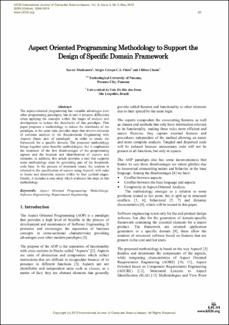| dc.contributor.author | Medianero P, Xavier S | |
| dc.contributor.author | Crespo, Sergio | |
| dc.contributor.author | Clunie, Clifton | |
| dc.date.accessioned | 2017-07-28T15:38:20Z | |
| dc.date.accessioned | 2017-07-28T15:38:20Z | |
| dc.date.available | 2017-07-28T15:38:20Z | |
| dc.date.available | 2017-07-28T15:38:20Z | |
| dc.date.issued | 2014-07-04 | |
| dc.date.issued | 2014-07-04 | |
| dc.identifier.uri | http://ridda2.utp.ac.pa/handle/123456789/1842 | |
| dc.identifier.uri | http://ridda2.utp.ac.pa/handle/123456789/1842 | |
| dc.description | The aspect-oriented programming has valuable advantages over other programming paradigms, but in turn it presents difficulties when applying the concepts within the stages of analysis and development to reduce the drawbacks of this paradigm. This paper proposes a methodology to reduce the drawbacks of the paradigm, at the same time provides steps that involve elements of common analysis in the Requirements Engineering with Aspects (basic unit of paradigm) in order to create the framework for a specific domain. The proposed methodology brings together some benefits methodologies, but it emphasizes the treatment of the first disadvantages of the programming aspects and the location and identification of aspects and elements; in addition, this article provides a tool that supports some methodology steps by generating part of the framework code base. In the process of treatment issues, the analysis is oriented to the specification of aspects using AspectJ, with rules to locate and determine aspects within its four Cyclical stages. Finally, it includes a case study which evaluates the steps in this methodology. | en_US |
| dc.description.abstract | The aspect-oriented programming has valuable advantages over other programming paradigms, but in turn it presents difficulties when applying the concepts within the stages of analysis and development to reduce the drawbacks of this paradigm. This paper proposes a methodology to reduce the drawbacks of the paradigm, at the same time provides steps that involve elements of common analysis in the Requirements Engineering with Aspects (basic unit of paradigm) in order to create the framework for a specific domain. The proposed methodology brings together some benefits methodologies, but it emphasizes the treatment of the first disadvantages of the programming aspects and the location and identification of aspects and elements; in addition, this article provides a tool that supports some methodology steps by generating part of the framework code base. In the process of treatment issues, the analysis is oriented to the specification of aspects using AspectJ, with rules to locate and determine aspects within its four Cyclical stages. Finally, it includes a case study which evaluates the steps in this methodology. | en_US |
| dc.format | application/pdf | |
| dc.language | eng | |
| dc.language.iso | eng | en_US |
| dc.rights | https://creativecommons.org/licenses/by-nc-sa/4.0/ | |
| dc.rights | info:eu-repo/semantics/openAccess | |
| dc.subject | Aspect Oriented Programming | en_US |
| dc.subject | Methodology | en_US |
| dc.subject | Software Engineering | en_US |
| dc.subject | Requirements Engineering | en_US |
| dc.subject | Aspect Oriented Programming | |
| dc.subject | Methodology | |
| dc.subject | Software Engineering | |
| dc.subject | Requirements Engineering | |
| dc.title | Aspect Oriented Programming Methodology to Support the Design of Specific Domain Framework | en_US |
| dc.type | info:eu-repo/semantics/article | |
| dc.type | info:eu-repo/semantics/publishedVersion | |
